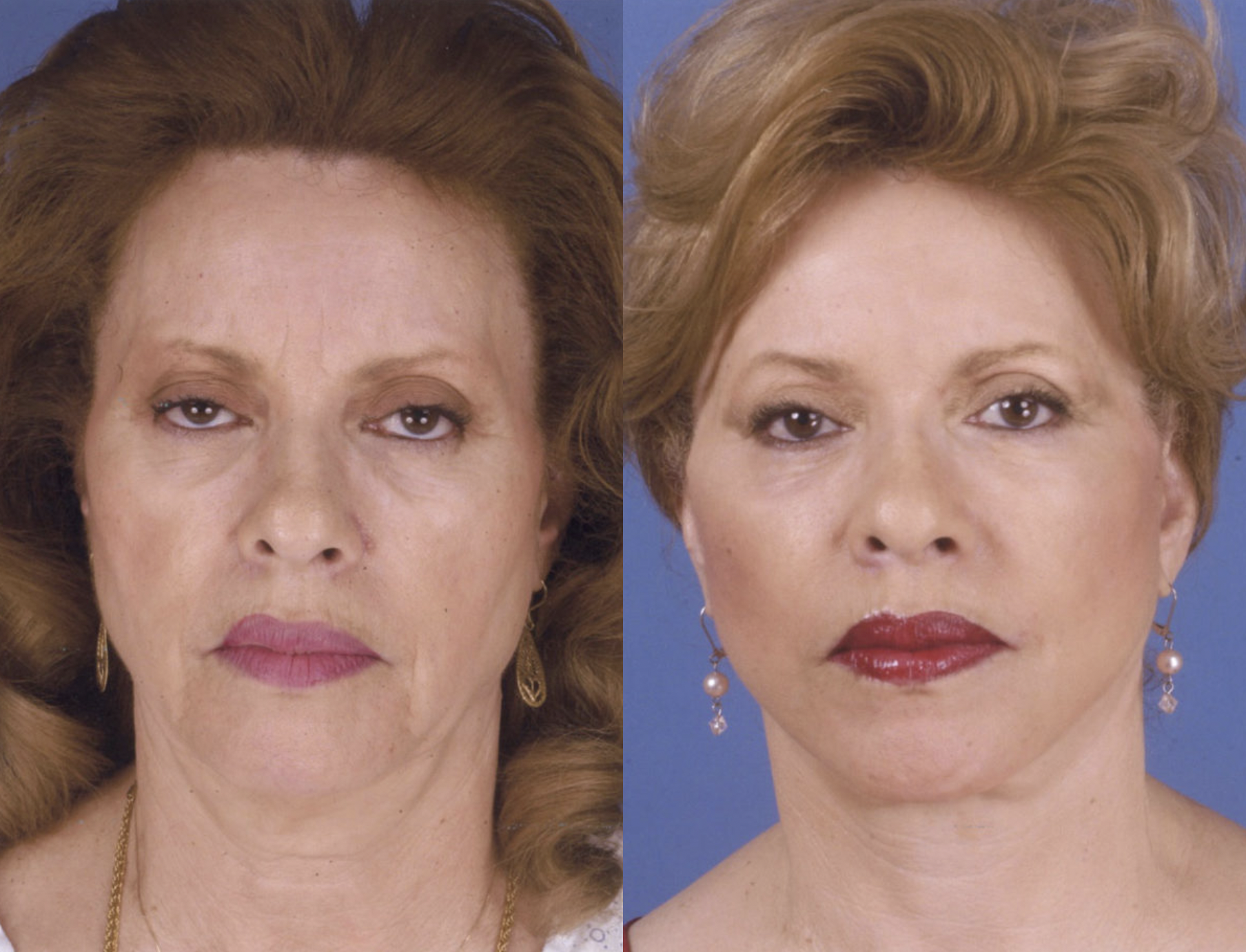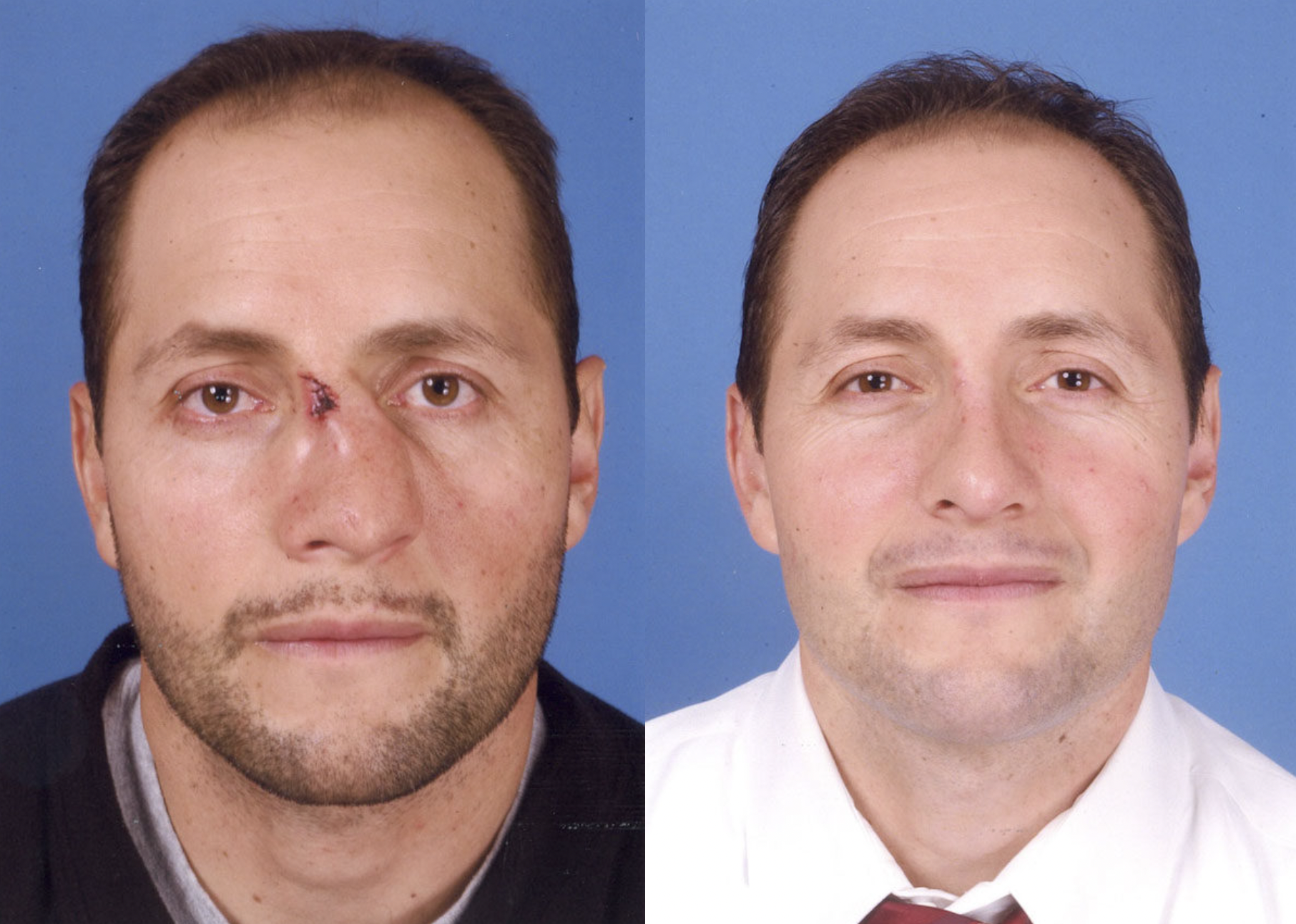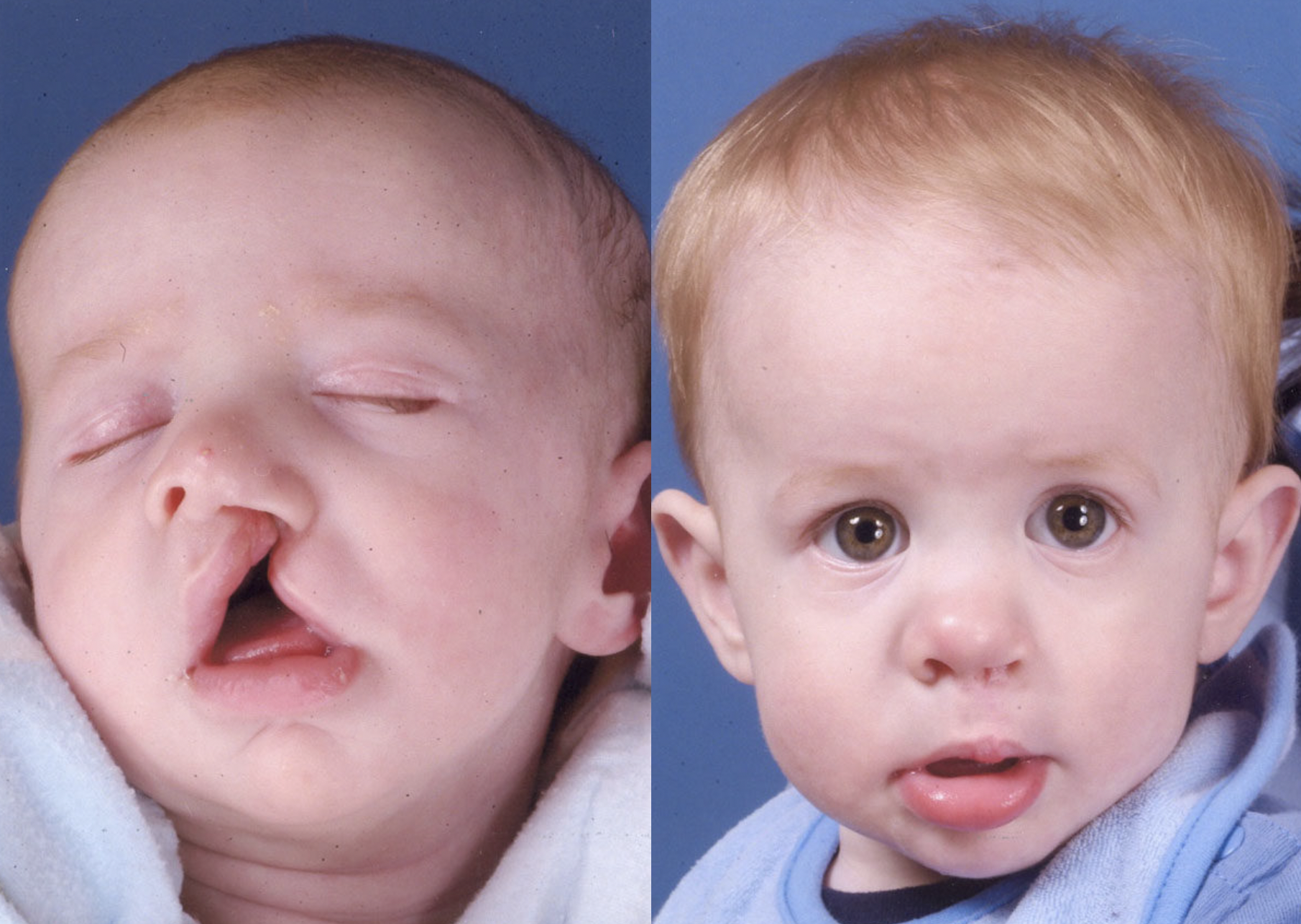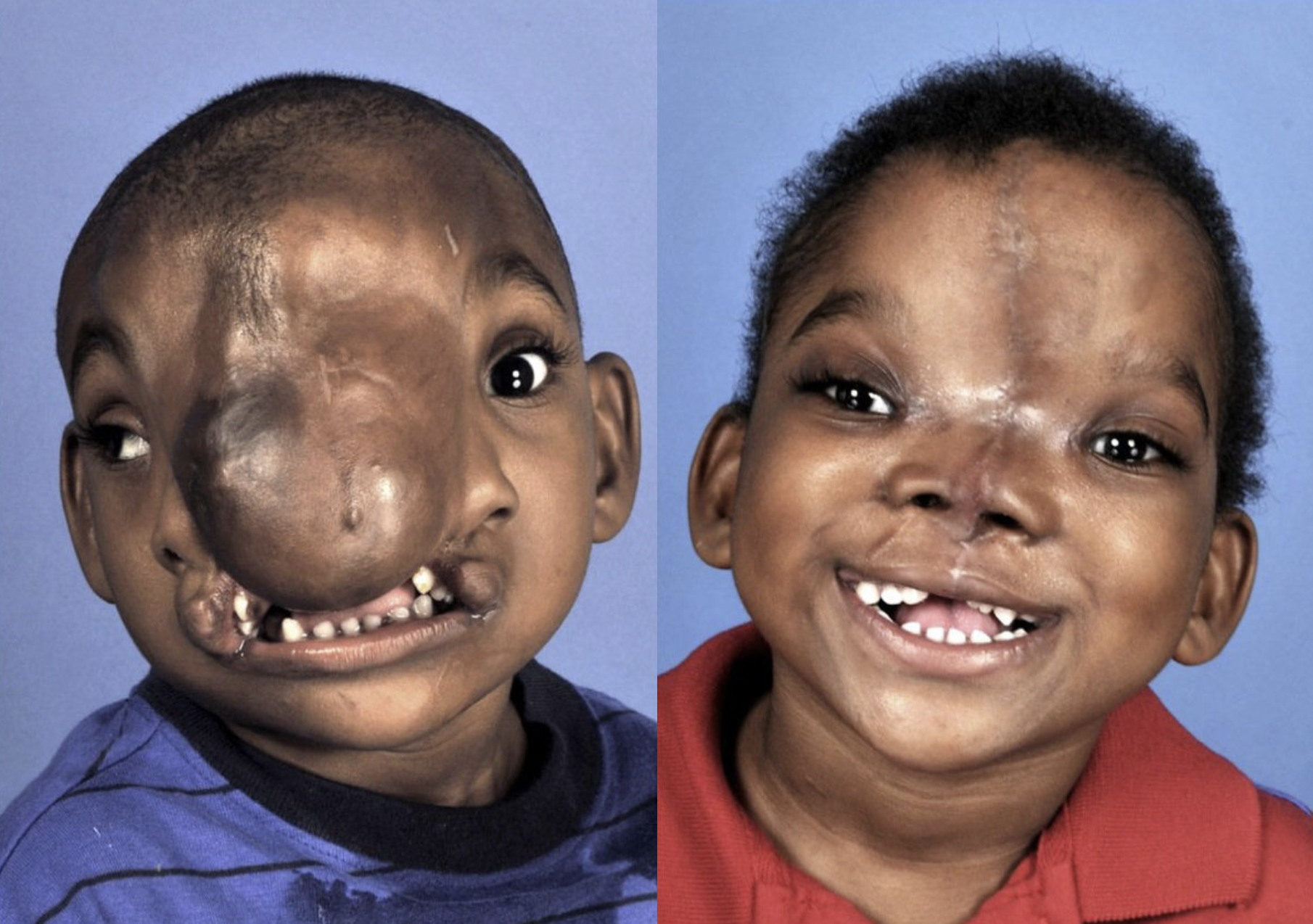Conveniently located to serve New York City, Queens, Bronx, Brooklyn, Long Island

Treacher Collins syndrome (TCS) is an extremely rare genetic condition that affects the development of a child’s facial features. Due to the condition’s varying severity, early diagnosis and intervention are vital, and Dr. James P. Bradley will work closely with other specialists to create a comprehensive approach.
Treacher Collins Syndrome
Treacher Collins Syndrome is typically bilateral and symmetrical and involves the outer eyelids, cheekbones, and jaws. The downward slanting outer corners of the eye from the missing or small cheekbone (zygomatic arch) give a saddened appearance, and the small lower jaw gives an open bite deformity. It ranges from a mild to a severe deformity. Since Treacher Collins is autosomal dominant, the condition can affect others in the same family.
Common Symptoms & Facial Features:
- Underdeveloped cheekbones (malar hypoplasia)
- Small jaw and chin (micrognathia)
- Downward-slanting eyes
- Cleft palate
- Ear abnormalities or absence of ears (microtia/anotia)
- Hearing loss due to malformed middle ear structures
- Breathing difficulties due to airway obstruction
The severity varies widely—some individuals have mild features, while others require multiple surgeries for functional improvement.
Cause of Treacher Collins Syndrome
Treacher Collins syndrome, also known as mandibulofacial dysostosis, is attributed to the genetic mutation of the TCOF1, POLR1B, POLR1C, or POLR1D genes. It may be inherited or appear sporadically without any family history.
Many parents do not know their child has the condition until the baby is born. However, regular ultrasounds during prenatal check-ups can detect severe facial deformities.
Diagnosis of Treacher Collins Syndrome
TCS can be diagnosed during a consultation with Dr. James P. Bradley. The baby’s physical characteristics will be thoroughly examined. Additional laboratory and imaging tests may be performed to check for abnormalities’ presence and/or extent. Molecular genetic testing is the best way to confirm the condition since TCS can exhibit symptoms similar to those of other craniofacial conditions.
Correction of Treacher Collins Objectives
- Improve cheekbone projection and support for the eyelids. (Zygomatic bone grafts/Eyelid switch flaps procedures)
- Rebuild the lower jaw to improve the airway and provide the best dental bite. (Distraction procedure)
- Create a new external ear from a child’s cartilage when needed. (Microtia repair)
- Transplant fat and soft tissue for a smooth, symmetrical cheek contour. (Fat grafting)
The Role of Surgery in Treating Treacher Collins Syndrome
Surgical intervention plays a central role in managing TCS symptoms that affect breathing, feeding ability, hearing function, and facial symmetry. While not all patients require surgery immediately after birth—many benefit from staged procedures throughout childhood into adolescence, depending on their individual needs.
Dr. James P. Bradley specializes in personalized treatment plans tailored to each patient’s anatomy and developmental stage using state-of-the-art craniofacial reconstruction techniques.
When Is Surgery Recommended for Treacher Collins Syndrome?
The timing of Treacher Collins surgery is highly individualized and depends on the patient’s specific needs and developmental stage. It often involves a staged approach, coordinated by a multidisciplinary craniofacial team over many years. General considerations include:
- Infancy: Priority is given to life-sustaining functions. Surgery may be needed early for severe airway obstruction (e.g., tracheostomy) or feeding difficulties (e.g., feeding tube).
- Early Childhood (Approx. 3-7 years): Procedures like mandibular distraction osteogenesis may be performed to lengthen the jaw, improving the airway and facial profile. Initial eyelid or cheekbone work might be considered.
- Mid-Childhood (Approx. 6-10 years): External ear reconstruction is often performed during this period, frequently using rib cartilage grafts. Cheekbone (zygomatic) and orbital reconstruction may also occur.
- Adolescence/Early Adulthood: Final jaw surgeries (orthognathic surgery), nasal surgery (rhinoplasty), genioplasty (chin surgery), and soft tissue refinements (like fat grafting) are typically performed after facial growth is largely complete.
Treatment for Treacher Collins
Each patient receives a different treatment approach since treatment is tailored specifically to address specific symptoms. Cleft palate, hearing loss, breathing difficulties, and mandibular problems can all be addressed to improve the patient’s quality of life.
Surgical intervention and reconstruction surgery may be necessary to correct severe deformities. Some surgeries will be performed after the child has fully developed facial structures, and other procedures cannot be performed until the patient is of legal age. Dr. Bradley will work closely with the child’s other specialists to create a comprehensive treatment approach.
Types of Treacher Collins Surgeries & Procedures
A range of surgical techniques may be employed in a comprehensive Treacher Collins treatment plan. Dr. Bradley is experienced in performing these complex procedures:
- Mandibular Distraction Osteogenesis: Gradually lengthening the lower jaw bone to improve the airway and facial balance
- Zygomatic (Cheekbone) Reconstruction: Using bone grafts (often from the skull or hip) or custom implants to build up underdeveloped cheekbones
- Orbital Reconstruction: Reshaping the bone around the eyes and repairing lower eyelid defects (colobomas) to support the eyes and improve appearance
- External Ear Reconstruction (Microtia Repair): Creating new external ears, typically using the patient’s own rib cartilage or synthetic implants. This addresses the visible ear deformity but often requires separate interventions for hearing loss
- Genioplasty: Reshaping or repositioning the chin to improve facial profile harmony.
- Orthognathic Surgery: Corrective jaw surgery performed after growth is complete to optimize bite alignment and facial aesthetics
- Soft Tissue Augmentation: Procedures like fat grafting can add volume to deficient areas of the face
- Nasal Reconstruction (Rhinoplasty): Reshaping the nose for improved aesthetics and function, often performed in later stages.
Recovery After Treacher Collins Surgery
The recovery process varies from patient to patient, depending on the extent and complexity of the procedures performed. Downtime for corrective surgeries can take a few weeks to several months. During recovery, follow Dr. Bradley’s post-surgical care directions as closely as possible.
FAQs about Treacher Collins
What is the right age for my child to start reconstruction?
The timing will consider functional problems, social integration, and minimizing the number of surgical procedures. Your child’s treatment plan, including the best timing of the procedures, is unique for your child. Many procedures, including jaw and ear reconstruction, happen between 5 and 8 years of age. ‘Final-stage’ procedures happen in the late teens.
Which specialists should be following my child?
Dr. Bradley will work closely with the ENT surgeon, orthodontist, speech pathologist, audiologist, and other specialists to meet all needs at the appropriate time.
Is surgery always necessary for Treacher Collins syndrome?
While the severity varies, most individuals with Treacher Collins syndrome benefit from or require surgery to address functional issues (breathing, hearing, feeding) and improve facial structure and appearance.
How many surgeries does a Treacher Collins patient typically need?
The number of surgeries is highly variable depending on the individual’s specific needs and the complexity of their condition. It often involves multiple procedures staged over many years, requiring a long-term commitment to treatment.
Will insurance cover Treacher Collins syndrome surgery?
In most cases, yes. Surgeries for Treacher Collins syndrome are generally considered medically necessary reconstructive procedures, not cosmetic. However, coverage details depend on the specific insurance plan. Our team can help verify your benefits.
What are the long-term outcomes of Treacher Collins surgery?
Long-term outcomes are generally very positive. Surgery can significantly improve function (breathing, hearing), facial balance, and appearance. This often leads to enhanced self-esteem and quality of life. Ongoing monitoring and potential minor revisions may sometimes be needed.

As a Cosmetic Surgeon known for his attention to detail, Dr Bradley has dedicated himself to delivering natural, balanced, and fresh results. View some of our patients who have achieved unbelievable results with the help of James P Bradley Plastic Surgery.
Why Choose Dr. James P Bradley
Dr. James P. Bradley offers an unmatched combination of expertise, innovation, and compassionate care that sets him apart as one of New York City’s premier craniofacial surgeons.
As a board-certified plastic surgeon whose practice is focused on intricate reconstructive procedures, Dr. Bradley possesses vast experience, specifically in diagnosing and performing Treacher Collins facial reconstruction, skillfully managing patients through the necessary multi-stage surgical journey inherent to this condition.
Contact Us Today
If you or your child has been diagnosed with Treacher Collins syndrome, expert surgical care can make a profound difference. Learn more about Dr. Bradley’s personalized approach to treating Treacher Collins in New York. Contact us today to schedule a consultation.
Your Treacher Collins Surgery procedure will be performed in James P Bradley, MD’s surgery center in New York.





